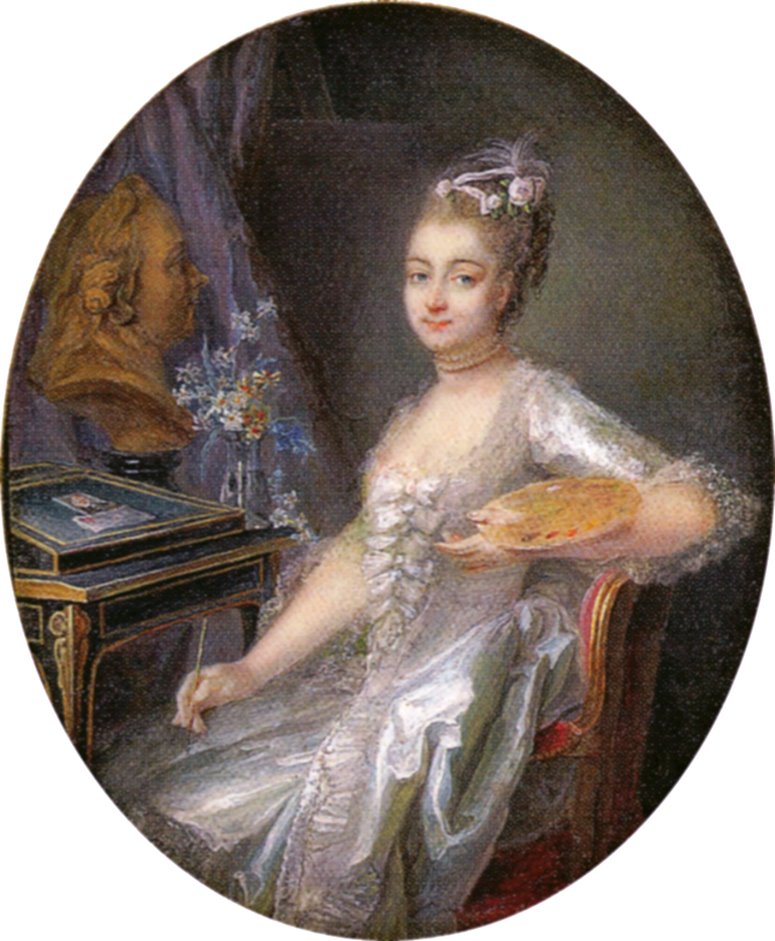 |
| "Self Portrait"(Oil) 1800, by Elisabeth Vigee Le Brun, Collection of the Hermitage Museum, Saint Petersburg, Russia |
 |
| "Self-Portrait"( Pastel) 1782 by Adelaide Labille -Guiard, Private collection |
Labille-Guiard and Vigee Le Brun were admitted into the French Royal Academy of Painting and Sculpture on the same day, May 31, 1783. It is only natural that the two figurative artists would be called rivals. Some say their "rivalry" was invented by critics who loved to compare the two women in every aspect, including their looks. In Laura Auricchio's monograph "Adelaide Labille-Guiard, Artist In The Age Of Revolution" she discusses an instance where women of the Royal Academy's Salon were compared as if they were participating in a beauty pageant "Mesdames Vallayer and Guiard also display their graces at the Salon; but Paris awards the apple to Madame Le Brun". 1
So since, I have seen the mention of rivalry many times when reading about Labille-Guiard or Vigee Le Brun, I thought it would be interesting to explore this topic.
Self-portraits at different stages of their lives reveal clear differences in the way they each presented themself to the public. The following are two self-portraits painted in their twenties. You can clearly see that Adelaide Labille-Guiard had a predilection for more elaborate style and dress as compared to Elisabeth Vigee Le Brun's preference for simpler dresses (as you can see in many of Le Brun's self-portraits).
 |
| "Self-Portrait (age 26) by Elisabeth Vigee Le Brun, Kimbell Art Museum Fort Worth, Texas |
 |
| "Self-Portrait" (age 25) Watercolor on Ivory, 4 1/16 in x 3 5/16 in, by Adelaide Labille- Guiard, Foundation Miniaturesammlung Tansey, Celle, Germany |
 |
| "Self-Portrait with Two Pupils" (age 36) by Adelaide Labille-Guiard |
 |
| "Self-Portrait" (age 35) by Elisabeth Vigee Le Brun, Uffizi Gallery, Florence, Italy |
Comparison of their personalities reveals that they were both tenacious women, both passionate about their art and found the way to create in a tough, chaotic world, a world of Revolution. They were extraordinary women.
Elisabeth Vigee Le Brun dedicated herself only to painting, she had as much as three sittings per day. In the evening she would sometimes have elaborate soirees, where she would invite poets, musicians, aristocrats and painters. She was very social in this respect. Her husband, Jean Baptiste Pierre Le Brun, was an art dealer and critic, who specialized in old master paintings. He also painted on occasion. Here is a self-portrait by him.
 |
| "Self-Portrait" by Jean-Baptiste-Pierre Le Brun, Wildenstein Institute, Paris |
Adelaide Labille-Guiard's great love was, Francois- Andre Vincent, who taught her oil painting (and helped her make the transition from miniaturist to large scale oil painting) He was the son of her miniaturist teacher, Francois-Elie Vincent, who was her instructor during her adolescence.
 |
| "Francois-Andre Vincent" 1795, by Adelaide Labille-Guiard, Louvre Museum, Paris |
I have already mentioned that Elisabeth Vigee-Lebrun spent most of her time painting, she did teach (upon the urging of her husband to earn extra income) but she did not love it. Adelaide Labille-Guiard was passionate about her teaching. She depicted herself in her self-portrait as a teacher and it turned out to be her masterpiece. She fought for the advancement of women artists in a hard time. Much of her time was spent campaigning to change the laws limiting the number of women allowed to exhibit their work in the all important Salon of the French Royal Academy. She succeeded and in 1791 a motion passed where an unspecified number of women were allowed to exhibit in the Royal Salon. Labille-Guiard was a great role model for women, who via her teaching and willingness to push the limits of the French art establishment made a difference.
Politics was another area the two women differed greatly in. In 1789, when the Revolution started to bare its claws in Paris, Vigee Le Brun fled to Italy,Vienna and Russia. Labille-Guiard remained behind, absorbed and even embraced the new regime that came into power in Paris. Labille-Guiard painted fourteen members of the National Assembly, including Maximilien Robespierre, the ultimate revolutionary. Vigee Le Brun's travel further helped spread her fame around the world, while Labille-Guiard always remained in France, surrounded by a close knit group of people.
Their painting styles reveal distinctions that clearly identify each artist. As seen below
in Adelaide Labille-Guiard's painting "Portrait of a Woman" her characteristic trademark style, is rich in clarity, detail and usually demure color.
 |
| "Portrait of a Woman" 1781 by Adelaide Labille Guiard, Musee de Beaux-Arts, Quimper, France |
 |
| "The Daughter's Portrait" 1792, by Elisabeth Vigee Le Brun, Galleria nazionale di Parma, Italy |
It is a matter of personal taste in deciding who gets the prize in this age old rivalry. One thing is for sure, they both qualify as winners in my book.
1 Les Pientres Volants, ou Dialogue entre in francois et un anglois sur les Tableaux exposes au Sallon
du Louvre en 1783, Collection Deloynes vol. 13. no 297, pg. 13 ------footnote of a quote Laura Auricchio used on pg. 35 in her monograph "Adelaide Labille-Guiard "Artist In The Age of Revolution"
No comments:
Post a Comment